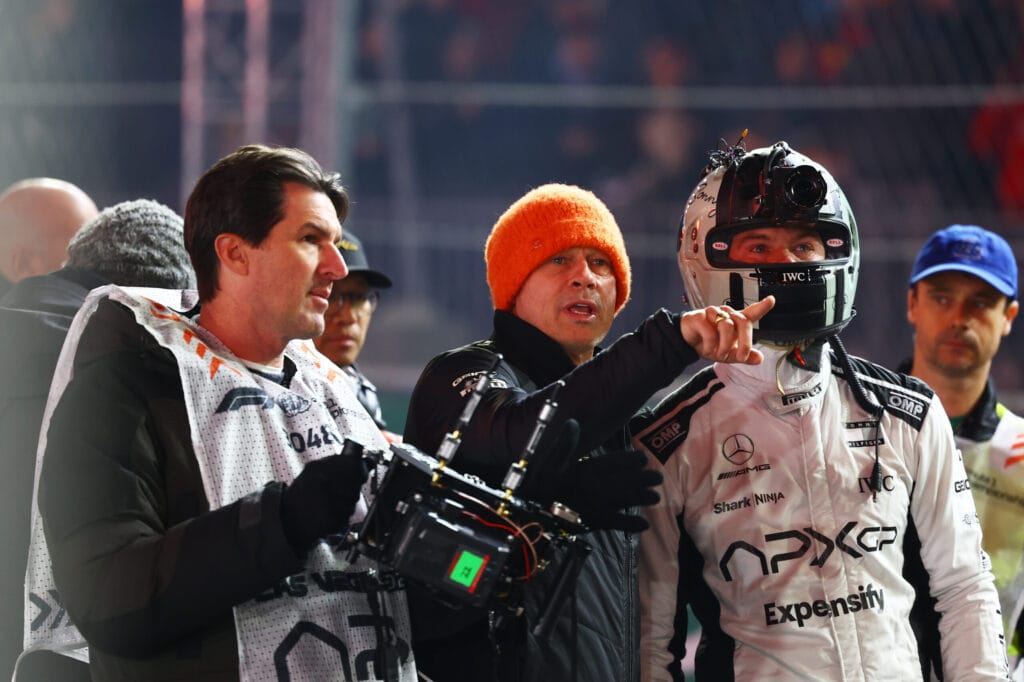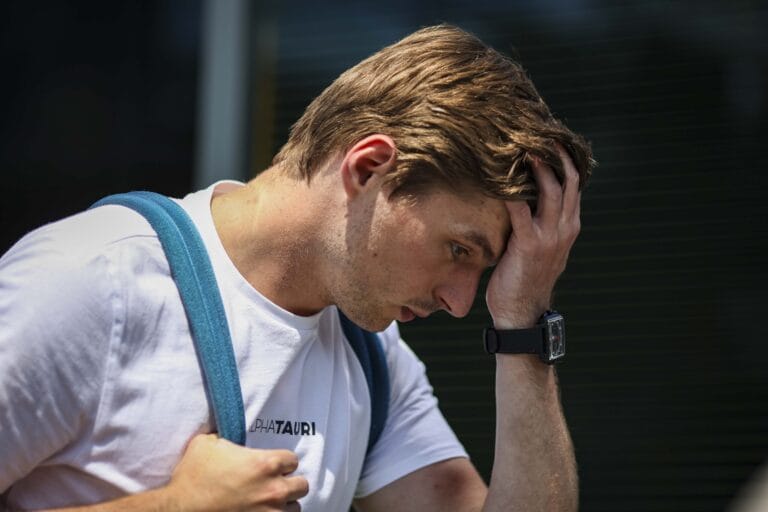Max Verstappen and his colleagues are now shining on the silver screen, alongside Brad Pitt, whose long-awaited film F1 is premiering worldwide this week. In conversation with director Joseph Kosinski: “Spending an entire day driving with Lewis Hamilton as an instructor: you’ll never forget something like that.”
He slumps in his chair, leans back, and nods a nearly shy hello. There’s no sign of the stereotypical Hollywood director, all preconceptions are immediately discarded. This is not a middle-aged man shouting with a cap and sunglasses on, nor is he holding a megaphone or sitting in a typical director’s chair, the kind that folds up with DIRECTOR written in capital letters on the back. No, none of that.
So, who is here, both literally and figuratively in the hot seat to talk about the film F1? Joseph Kosinski. As it turns out, he’s a committed professional. A director with an impressive resume (including Top Gun: Maverick) and above all, a man who speaks about Formula 1 with an unmistakable mix of love and passion. “We really tried to do justice to the sport with our film. Because that’s what Formula 1 deserves.”
Appreciation
Kosinski says this in a tone that can be described as sincere and respectful. His appreciation is evident when he talks about Formula 1. Appreciation for the drivers, teams, mechanics, and everyone else in the sport to which he says he has given his heart. The sport in which he felt welcome from the first minute of filming. And in which the entire crew, not least lead actor Brad Pitt, had long and often unrestricted access.
“A sport that we were more or less allowed to be part of as the eleventh team in the paddock, in the pits, and on the circuit,” Kosinski states. “Not really, of course, but the amount of access, help, and opportunities we received from everyone in Formula 1 was truly heartwarming.”
And: absolutely necessary, in order to do it as well as possible. Because let’s be honest: films about motorsport in general and Formula 1 in particular have not excelled in quality, realism, entertainment value, or a combination of all these in recent decades. Kosinski, Pitt, producer Jerry Bruckheimer, and Formula 1 enthusiasts within the crew were therefore genuinely keen to make F1 a success. No means, both practical and financial, were spared for this.
The film not only features a typical American feel-good story, but also showcases unique technology, an impressive collection of camera shots, and of course, appearances by real racers. These include scenes of actual battles with Pitt or at podium ceremonies. But how is this achieved? Kosinski provides some insight, without revealing the film’s budget. He dismisses figures like 300 million dollars as mere fables.
What Preceded (1)
It’s December 2021 when a distinguished group gathers somewhere in Los Angeles. Among them are Pitt and Kosinski, as well as Bruckheimer. The renowned film producer (known for Pirates of the Caribbean, Armageddon, Top Gun, Beverly Hills Cop, and more) sees potential in a Formula 1 film. The film studios also see potential: a bidding war is imminent. Somewhat surprisingly, Apple emerges as the winner, reportedly willing to spend 130 to 140 million dollars to develop and film the idea.
Over a year and a half later, in the summer of 2023, filming begins at the Silverstone circuit; the British Grand Prix is the first of a series of races where various scenes are shot on and off the track. Amidst the audience, teams, other racers, and even during sessions and the races themselves. “We’ve started,” says Kosinski, grinning broadly in the paddock.
A year later, it is announced that the renowned company Warner Bros. will handle the film’s worldwide distribution. And the title of the film? It sees the light of day in July 2024: F1.
On the Circuit
As it turns out, filming over the past year and a half has not been easy. A film in itself is a traveling circuit, as is Formula 1 as a sport. This presents an extra challenge for the filmmakers. “But we’re not complaining, we received all the cooperation,” reflects Kosinski, over a year after the start of filming. The shoots took place not only in Silverstone, but also on circuits in Zandvoort, Budapest, and Las Vegas. The director provides a glimpse into the workings of the shooting days.
“Of course, we couldn’t film during an actual race, but we could before and after. Or after a free practice session. We were given time slots of ten to fifteen minutes by the organization. As the training was coming to an end, Brad and Damson, as actors, were already strapped and packed in the cars. Helmets on, engine running, tires warmed up. So we could hit the track immediately. We would then do three takes in ten minutes, which would normally take a whole day on a regular set with more time.”
And all this in front of sometimes a hundred thousand spectators on the track, even without them sometimes realizing what was happening right before their eyes. Kosinski: “And in the meantime, we were filming everything with 24 to 30 cameras, from all angles and in all sorts of ways. Fast, intense shots. And then also shooting scenes before races or afterwards on the podium.” Or, as will be seen in the film, in battle with the cars of real drivers like Charles Leclerc or George Russell who then specially got in to drive a few laps.
Kosinski: “In the end, we as filmmakers also worked entirely on adrenaline during such a race weekend. Just like the drivers. You can’t fake that, it was real. Hopefully, people will experience that when they watch the film.”
What Preceded (2)
Extra special is the role of Hamilton, not only on the big screen, but also beyond. A few years ago, Kosinski decided to take the plunge. “One of the first things I did for this film was to approach Lewis Hamilton through mutual contacts. I asked him to participate, to become a partner of the film. To help us, purely in terms of content: as a seven-time champion, he obviously knows everything about the sport. He was open to it and then introduced me to Toto Wolff. He also helped us a lot with Mercedes.”
It was Wolff, for example, who had a major share in the cars used for the film. “On his advice, we bought six Formula 2 cars, real racing cars. And we worked on them with engineers and mechanics from the Mercedes Formula 1 team.”
They converted the cars into F1-worthy cars, at least on the outside. Film technicians then took care of all the (dozens of) cameras, microphones, and other parts on the cars to offer as realistic an experience as possible to the viewers, according to the director.
“And,” Kosinski states, “we wanted them to remain real racing cars. So we had to find a middle ground to make the cars strong enough to carry all our camera equipment and other technical stuff. And in such a way that they could still really drive fast. With a truly driving Brad Pitt in the cockpit.”
At certain moments, stunt people, so-called ‘body doubles’, were used. Not behind the wheel, according to the director: “Every time you see Brad Pitt or Damson Idris in the car, it’s real: they drove themselves, in real cars, on real F1 circuits. And that’s very cool.”
Returning to Lewis Hamilton‘s role, it wasn’t just his advice or network that proved useful, but also his driving skills. After all, you don’t just ‘hop into’ an F2 car, especially if you’re an actor unaccustomed to it. Kosinski agrees. “That’s why we trained for months. Or rather, the actors did.” He laughs, “I also got to participate and drive for a day. It was fantastic, Brad, Lewis, and I were all at the Silverstone circuit together. Spending the whole day driving sports cars, with a seven-time world champion like Lewis Hamilton as your instructor: it’s an experience you’ll never forget.”
But aside from being fun and unique, it was also an absolute necessity for the director. “If Brad couldn’t drive himself, it wouldn’t work in my opinion. Fortunately, Lewis quickly concluded that Brad had a feel for it. Whether that’s innate in Brad, or where he gets it from, I have no idea. He also rides a motorcycle, maybe that helps. But either way, I was relieved, because it makes the film more beautiful and authentic.”
Whether the experience was positive or negative, only the actor himself can say. Although? Kosinski, with a meaningful smile, says, “Brad wasn’t acting while driving, he was genuinely trying to keep the car on the track…”
Blockbuster
Whether he succeeded and how will be revealed in the final film as it appears in cinemas worldwide. Naturally, Kosinski, Bruckheimer, Pitt, and all the other participants hope the film will be a blockbuster. The same hope exists within Formula 1; it’s no coincidence that all opportunities were provided to make F1 a success.
Music, which is particularly important for films, was also heavily invested in. The world-famous Hans Zimmer took care of the soundtrack, with captivating and thrilling music as you would expect from Hollywood. Zimmer has previously been responsible for the film music of dozens of blockbusters.
The film may not do much for the popularity of the sport; the ‘Netflix effect’ is hard to surpass. Interestingly, the success of the multi-year documentary series Drive To Survive was a source of inspiration for Kosinski.
“What I love about that series, for example, is how it takes the viewer into the workings of smaller teams, instead of just showing what it’s like at Ferrari, Mercedes, or Red Bull. A small team trying to achieve success, as an underdog, that partly inspired me for this project. I find it inspiring. And I can enjoy it; hopefully, people will too, but from this film.”


